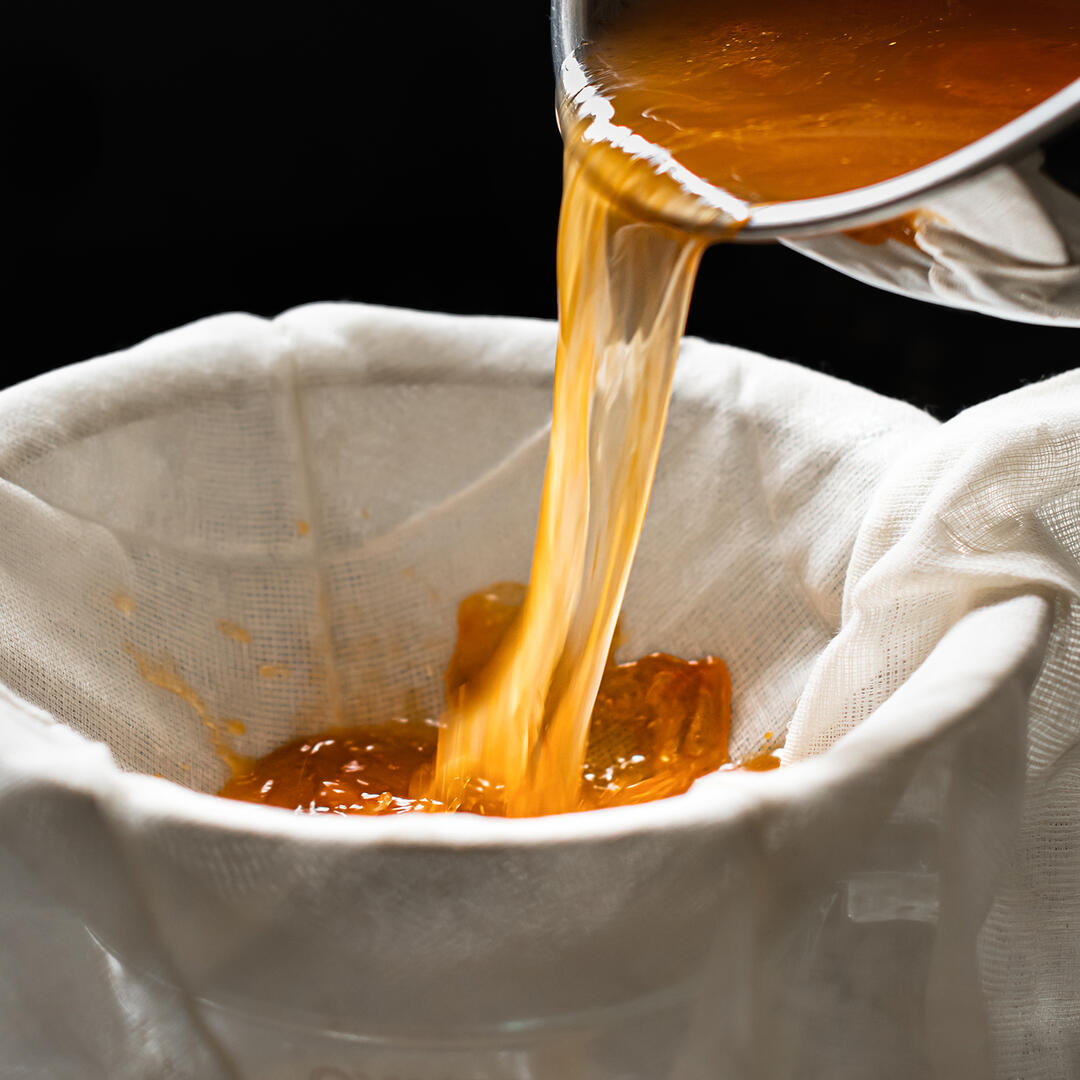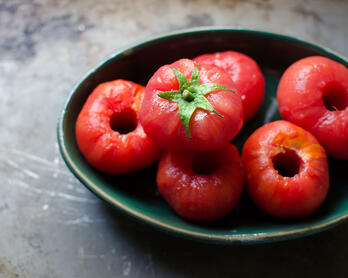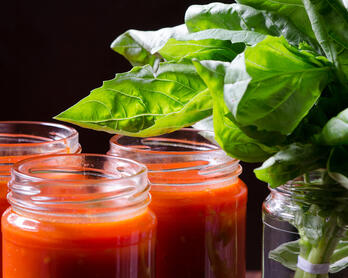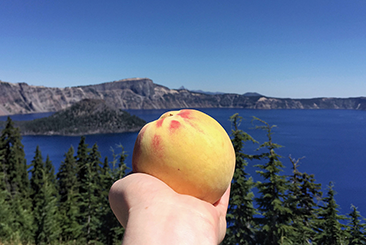Tomato Water

This recipe post (though it's a stretch to call it a recipe) was inspired by Chef Jeremy Fox and his tomato water focaccia. Adding tomato water to bread is one of those ideas hiding in plain sight and I was jazzed to try it. Thankfully, the summer shoulder season means peppers and tomatoes are still available so I picked up a bag of Early Girls and Romas and hustled home to make some water. I would have been willing to go all in with a project but harvesting the pumpkin-hued liquid from my fruit turned out to be a quick task.
It was surprising to my bread-obsessed brain how few recipes involve adding tomato water to any kind of dough. There were even fewer recipes for making tomato water, most calling for puréeing and straining fresh tomatoes then discarding the pulp. I'm imperfect when it comes to minimizing waste but didn't love the idea of mashing up beautiful fruit just for its juice.
The solution came about almost by accident when I was making Gjelina's Pomodoro Sauce. That process involves simmering the sauce to evaporate excess liquid and thicken the texture. Rather than cooking for an extended time, I just drained a bit of the tomato water from the pomodoro tomatoes to use for bread. Making tomato water ended up being a 5-minute task that ultimately built an efficiency into my sauce prep.
My liquid treasure made its first appearance in a successful batch of Tomato Water Sourdough Pita. The whole grains, sourdough starter, and hint of summertime are so satisfying. The tomato water tastes fantastic on its own and there are a number of uses for it including vinaigrette, cocktails, and stock. At the moment however, I'm focused on bread. The next move is to add tomato water to Sourdough Sicilian Pizza and then follow that up with rosemary bread.
The Pomodoro Sauce circle of no waste is now (unintentionally) complete. The skins are living a second life in Tomato Salt, the water made its way into pita, and the rest is carrying on in sauce so good the smell makes your jaw tingle. If you aren't sure what to use tomato water for, freeze it in 1/4 to 1/2 cup portions for a later date.
Go forth and seek out all the tomatoes before winter comes.

Recipe Tip
Tomato Variety
If you want a side of tomato water when making Gjelina's Pomodoro Sauce, use a higher percentage of juicy tomatoes like Early Girls in place of the sauce tomatoes (Roma, San Marzano). This ensures that there's still enough moisture for simmering after you drain off some of the liquid.
To Salt Or Not To Salt
Salt helps tomatoes release their liquid during the first steps of making pomodoro sauce and some of that salt ultimately ends up in the tomato water. The challenge this can present for a baker is trying to account for the sodium when making bread. Salts inhibits yeast activity and strengthens gluten - it's truly a science - so guesstimating the calculations with those sorts of inclusions can be tricky. With that said, I backed into the baker's percentages to give those interested something to work with when adjusting their recipe. Please correct me in the comments if I got some of these numbers wrong.
This section is for those that want to geek out on ratios.
- Diamond kosher salt is 8.5 grams per tablespoon.
- 4lbs of tomatoes yields about 24 ounces/711 grams of tomato water when using a mix of Roma and Early Girls.
Let's say all of the salt ends up in the tomato water. It probably doesn't but for the sake of easy numbers we'll go with that. To calculate approximately how much salt is in the liquid:
- grams of salt / (liquid yield/100) = amount of salt per 100 grams tomato water
- for the example above 8.5 / (711/100) = 1.2 grams salt per 100 grams of tomato water
The original naan/pita recipe includes 90 grams of filtered water. Swapping in tomato water will add about 1.08 grams of salt bringing the total salt in the flatbread to 1.8%. Generally speaking, sourdough bread recipes suggest anywhere from 1% to 2% salt so technically 1.8% is still in range. With that said, I reduce the fine sea salt in the dough a touch when using my salty tomato water since the original pita recipe only has 1.3% salt.
Farmers | Artisans
I make an effort to source my food from California artisans with a special focus on the Santa Monica Farmers Market. Below is a list of the folks who contributed to this dish.
- Munak Ranch // Tomatoes
- Finley Family Farms // Tomatoes
- Coleman Family Farms // Tomatoes
Tools
- Rösle Food Mill - This one is a favorite for both its form and function. The Rösle food mill effortlessly skins and processes mashed potatoes, applesauce, pomodoro sauce, and more. An alternative is the OXO ricer. I have one at my mother-in-law's house and found it works well for mashed potatoes and applesauce. One note is that I process smaller quantities and peel everything first when using the OXO tool.
- Immersion Blender - I use this tool often for Pomodoro Sauce, Almond Milk, pizza sauce, and more. It does a great job and is easy to clean. The whisk attachment comes in handy when whipping egg whites or making a small bowl of whipped cream.
- Large Non-reactive Pot (or here)
- All-Clad Fine Mesh Strainer (set linked) - Mesh strainers serve as flour sifters, rice rinsers, and roasted eggplant drainers.
- Ultra-fine Cheesecloth
- BPA-free Storage Containers
Ingredients
- 4 pounds tomatoes, mix of Early Girls (or similar juicy tomatoes) and sauce tomatoes (Roma, San Marzano).
- 1/4 cup olive oil
- (See Recipe Tips) 1 tablespoon Diamond kosher salt
Instructions
- Prepare pomodoro sauce as per the instructions through step three (three being when the tomatoes are submerged in their liquid). While the tomatoes are simmering, set a mesh strainer on a large measuring cup or bowl and line the strainer with two layers of fine cheesecloth. Set aside.
- Once the tomatoes have dumped their liquid and before you put them through the food mill, transfer everything in the pot to the mesh strainer and let it drain. Don't worry if too much liquid drains off since you can always add some back into the pomodoro sauce. Strain through ultra fine cheesecloth - 2 layers. If you find your particular cheesecloth is letting solids through, triple it up. I ended up with 3 cups of tomato water and 1 1/2 pounds of tomato puree.
- If you feel the puree is a too thick, just add some of the tomato water back. You want to have enough liquid in the sauce to allow it to simmer (covered) for a short while. In all cases, but especially with quick-simmered sauce, a night in the refrigerator is needed to marry up the basil and other flavors.
- Note: This recipe does not include the full amount of salt called for in Gjelina's Pomodoro Sauce. If that's what you want to make, check back with the recipe and adjust the salt as needed.
Newsletter
Subscribe at the bottom of this page for the Chic Eats roundup. It includes new and updated recipes along with a grab bag of content that was interesting enough to share around the dinner table.






